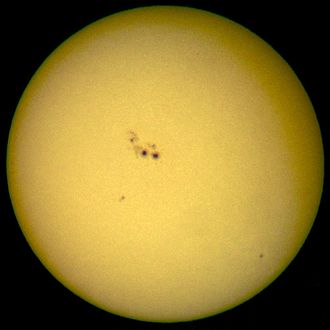m (1 revision) |
|||
| (One intermediate revision by the same user not shown) | |||
| Line 2: | Line 2: | ||
A sunspot is a region on the Sun's surface that is marked by a lower temperature than its surroundings and intense magnetic activity, forming areas of low surface temperature. Although they are blindingly bright, at temperatures of roughly 4000-4500° K, the contrast with the surrounding material at some 5700° K leaves them clearly visible as dark spots. If they were isolated from the surrounding photosphere they would be brighter than an electric arc. | A sunspot is a region on the Sun's surface that is marked by a lower temperature than its surroundings and intense magnetic activity, forming areas of low surface temperature. Although they are blindingly bright, at temperatures of roughly 4000-4500° K, the contrast with the surrounding material at some 5700° K leaves them clearly visible as dark spots. If they were isolated from the surrounding photosphere they would be brighter than an electric arc. | ||
<br style="clear:both"/> | <br style="clear:both"/> | ||
| + | |||
| + | [[Category:Adventist Youth Honors Answer Book|{{SUBPAGENAME}}]] | ||
Revision as of 15:49, 16 May 2012
A sunspot is a region on the Sun's surface that is marked by a lower temperature than its surroundings and intense magnetic activity, forming areas of low surface temperature. Although they are blindingly bright, at temperatures of roughly 4000-4500° K, the contrast with the surrounding material at some 5700° K leaves them clearly visible as dark spots. If they were isolated from the surrounding photosphere they would be brighter than an electric arc.

